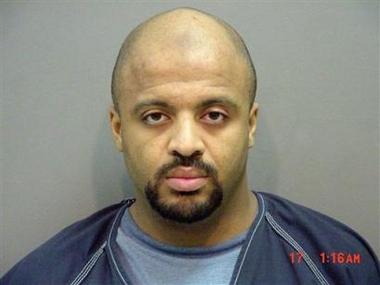Convicted Sept. 11 conspirator Zacarias Moussaoui began serving his life
sentence at the nation's most secure prison on Saturday after U.S. marshals flew
him overnight to southern Colorado from Virginia.

In this photo provided by the Carver County,
Minn., Sheriff's Department, Zacarias Moussaoui is seen in this Aug. 17,
2001, file photo in Chaska, Minn. [AP] |
Marshals brought Moussaoui, prisoner 51427-054, before dawn to the Supermax
federal prison, where he will spend 23 hours a day in his cell and have little
to no contact with the other notorious criminals.
"He has now begun serving his sentence of life without the possibility of
release," the U.S. Marshals Service said in a statement.
Moussaoui was the only prisoner aboard the small jet operated by the agency
as he flew with a special team of deputy marshals to Florence, Colo., about 90
miles southwest of Denver.
"All the inmates transferred there are handled with the highest level of
security," said Ken Deal, chief deputy US marshal in Denver.
Deal said he did not know whether the 37-year-old Frenchman made any
statements during the transfer.
Moussaoui arrived at 5:17 a.m. EDT, the Federal Bureau of Prisons said in a
statement. Prison spokesman Todd Javernick refused to say whether Moussaoui made
any comments.
At the prison, Moussaoui exchanged his green jump suit for a tan prison
outfit.
The $60 million Supermax, formally called Administrative Maximum, was built
in 1995 in a town of 3,600 people. The triangular, two-story prison was designed
for inmates once held at the U.S. Penitentiary in Marion, Ill., which had
replaced Alcatraz when it closed in 1963.
Among the inmates at the prison are Ramzi Yousef, Eric Rudolph, Ted Kaczynski
and Terry Nichols. Also there is Richard Reid, the would-be shoe bomber
Moussaoui said was to help him fly a fifth plane into the White House. The
Bureau of Prisons said the Supermax currently houses 398 "of the nation's most
violent, disruptive and escape prone inmates."
The transfer came on the same day that Moussaoui's court-appointed lawyers
appealed his life sentence and the denial of his request for a new trial.
In a one-paragraph notice of appeal, the lawyers said Moussaoui wanted the
4th U.S. Circuit Court of Appeals to review the final judgment and sentence he
received May 4 and Judge Leonie Brinkema's May 8 denial of his request to
withdraw his guilty plea and go to trial on the original charges.
Since Moussaoui's sentencing, he has said he lied when testifying at his
sentencing trial that he was to hijack a fifth jetliner on Sept. 11, 2001. He
has returned to claiming ¡ª as he had for four years before the trial testimony ¡ª
that he had nothing to do with the suicide hijackings that took nearly 3,000
lives.
Moussaoui was in jail in Minnesota on immigration charges when the attacks
took place. But he has admitted he was training to hijack a 747 jetliner and fly
it into the White House as part of a later plot to gain release of a radical
Egyptian sheik who is serving a life term for terrorist acts.
Moussaoui pleaded guilty in April 2005 to six counts of conspiring with
al-Qaida to fly planes into U.S. buildings. A jury considering the three counts
that carry the death penalty decided he was eligible for execution. They could
not agree unanimously that he deserved it, so he was automatically sentenced to
the lesser and only other penalty permitted: life in prison.
Brinkema sentenced him to six life terms, to run as two consecutive life
sentences.
At Supermax, the soundproofed cells were designed so inmates cannot make eye
contact with each other. Each 7-by-12-feet cell has a long, narrow window
looking out at other prison walls or the small concrete recreation yard.
Concrete platforms topped with mattresses function as beds. Each cell also
contains a concrete stool, shower and toilet.
Inmates get one hour out of their cells each day to eat or play basketball or
handball, though some earn longer recreation periods through good behavior. They
can take academic courses via closed-circuit television in each cell. Religious
services are conducted in a small chapel.